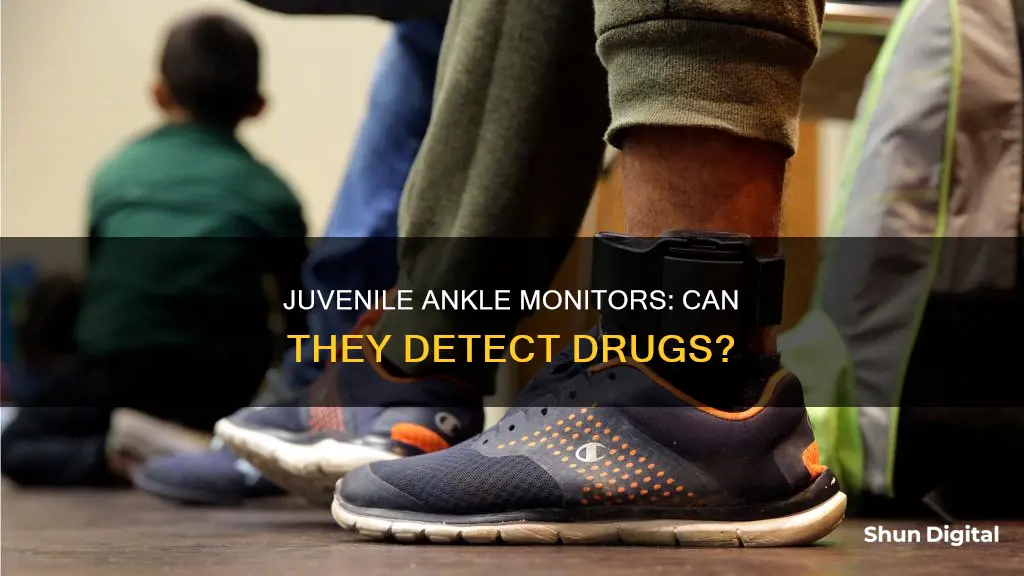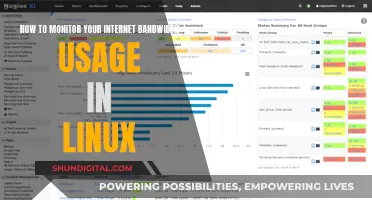
Ankle monitors are commonly used as an alternative to incarceration or as a condition of parole or probation. They are designed to track the movements and activities of individuals and ensure compliance with court-imposed restrictions. While they are not primarily designed for drug detection, some versions do have the capability to monitor alcohol consumption. Ankle monitors, as they are commonly used, do not have the ability to directly detect drugs in a person's system. However, drug testing programs can be used in conjunction with ankle monitors.
| Characteristics | Values |
|---|---|
| Purpose | Track movements and enforce compliance with court-imposed restrictions |
| Drug detection | Limited capabilities; cannot directly detect drugs in a person's system |
| Alcohol monitoring | Some versions can monitor alcohol consumption through transdermal alcohol monitoring or SCRAM technology |
| GPS tracking | Utilize GPS technology to track and monitor the movements and locations of individuals |
| Radio frequency monitoring | Establishes proximity between the device and a base station at the individual's residence |
| Alert system | Alerts can be sent to the wearer, and authorities can be notified if the individual enters or leaves a designated area |
| Two-way communication | Some monitors have a speaker that allows authorities to communicate with the wearer covertly |
| Waterproof | Some devices are waterproof up to 4 feet |
| Tamper-proof | Devices are designed to be difficult to remove and will alert authorities if tampered with |
What You'll Learn

Ankle monitors can track location and movement
Ankle monitors are electronic devices worn by individuals under supervision, often as an alternative to incarceration or as a condition of parole or probation. These devices are primarily designed to track the movements and activities of the wearer, ensuring compliance with court-imposed restrictions.
Ankle monitors typically utilise GPS (Global Positioning System) technology to monitor the wearer's location. This allows authorities or parents, in the case of juveniles, to keep track of the individual's whereabouts in real time. With GPS analytics, officers or parents can quickly identify patterns of movement and receive alerts when the wearer enters or leaves a designated area.
Some ankle monitors also rely on radio frequency technology to establish proximity to a base station, usually installed at the wearer's residence. This technology helps ensure compliance with home confinement rules. Additionally, these devices are tamper-proof, and any attempts to remove them will immediately notify the relevant authorities or parents.
The combination of GPS and radio frequency technologies enables precise tracking of the wearer's location and movement, providing a comprehensive approach to supervision.
Best Places to Buy Compact Side Monitors
You may want to see also

They can also monitor alcohol consumption
Ankle monitors, also known as SCRAM bracelets, are commonly used to monitor the movements and activities of individuals who are either serving their sentences or are on probation. While the primary function of these devices is location tracking, some advanced ankle monitors are capable of detecting alcohol consumption in addition to tracking location and movement.
SCRAM stands for "Secure Continuous Remote Alcohol Monitor." These bracelets work by monitoring the wearer's perspiration every 30 minutes, testing for the presence of alcohol excreted through the skin. This non-invasive method of alcohol detection provides accountability and encourages compliance with court orders.
The SCRAM bracelet can distinguish between alcohol consumption and external environmental sources of alcohol, such as the use of products containing alcohol. It is important to note that the bracelet is not triggered by hand sanitiser, which is applied topically rather than consumed orally.
The data from the SCRAM bracelet is transmitted wirelessly to a base station, which then sends it to a private company for monitoring. If the bracelet detects alcohol consumption, the company reports it to the court or the probation department. This can result in severe consequences for the offender, such as termination of probation or jail time.
While SCRAM bracelets are highly accurate, there is a small chance of false positives or negatives. For example, products containing alcohol, like perfume, lotions, mouthwash, or hand sanitiser, could potentially trigger the monitor. However, the chances of a false positive are minimal, and the bracelets can usually differentiate between actual alcohol consumption and environmental factors.
In conclusion, while ankle monitors are primarily designed for location tracking, some types, like SCRAM bracelets, can also monitor alcohol consumption. This technology provides an innovative way to carry out continuous alcohol monitoring and ensure compliance with court orders or probation requirements.
Connecting Sony Monitors to VGA: A Step-by-Step Guide
You may want to see also

They do not directly detect drugs in the system
Juvenile ankle monitors, also known as electronic monitoring devices or ankle bracelets, are used to track the movements and activities of individuals. They are often used as an alternative to incarceration or as a condition of parole or probation. These devices are designed to ensure compliance with court-imposed restrictions, such as curfews or house arrest.
While ankle monitors have various functions, including GPS tracking, radio frequency monitoring, and alcohol monitoring, they do not have the capability to directly detect drugs in a person's system. Their primary purpose is to monitor movements and locations, rather than conduct substance-specific tests.
The focus of ankle monitors is on tracking and enforcing compliance with restrictions, making them effective tools for ensuring individuals adhere to their assigned limitations. However, they do not directly detect the presence of drugs.
It is important to note that drug testing programs can be used alongside ankle monitors. These programs may include regular drug tests, such as urine or blood tests, which can detect drug use. By combining ankle monitors with drug testing, a more comprehensive approach to monitoring individuals at risk of drug use or relapse can be achieved.
While technological advancements may lead to enhanced drug detection capabilities in the future, for now, ankle monitors primarily serve as tracking devices rather than drug testing tools.
Ankle Monitor Malfunctions: What to Expect When It Goes Off
You may want to see also

They are used as an alternative to incarceration
Ankle monitors are often used as an alternative to incarceration, allowing individuals to serve their sentences while remaining in the community. They are typically used for people on probation or parole or those awaiting trial. They can also be used for low-risk individuals convicted of a crime who are not considered a danger to the community.
One of the main advantages of ankle monitors is that they are less expensive than incarceration and allow individuals to maintain their jobs and support their families. This can aid in their reintegration into society once their sentences are complete. Ankle monitors are also used by parents who want to keep track of their teenagers' whereabouts.
However, ankle monitors have been criticised for causing many of the same harms associated with incarceration. For example, they deprive people of fundamental rights, violate privacy norms, jeopardise employment opportunities, and undermine family and social relationships. People wearing these monitors are often required to remain at home unless they obtain pre-approval for any outings, which must be sought well in advance. This restriction on movement can make it difficult to attend after-school activities, pick up extra shifts at work, or even run errands.
In addition, most jurisdictions require individuals to pay expensive user fees for the ankle monitors, which can amount to hundreds of dollars per month. This cost is in addition to court costs and other expenses, such as phone and internet service fees, which are necessary to maintain contact with supervising agents.
While ankle monitors do not directly detect drugs, they can be used in conjunction with drug testing programs to provide a more comprehensive approach to monitoring individuals at risk of drug use or relapse.
Understanding Monitor HRZ: A Quick Guide to Know Yours
You may want to see also

They are also used by parents to monitor their children
Ankle monitors are used by parents to keep track of their children, especially those who have a history of running away or sneaking out of the house. While some companies market these devices to parents, the use of ankle monitors on children has been criticised as a form of authoritarian parenting that may erode trust and damage the parent-child relationship.
Ankle monitors for children are typically marketed as a way to ensure children stay within designated areas, such as the home or school. These devices are often tamper-proof and can alert parents if their child attempts to remove them. Some ankle monitors also feature two-way communication and a piercing alarm that can be activated if the child does not comply with instructions to return to the designated area.
While ankle monitors can provide parents with peace of mind and a sense of control over their child's whereabouts, critics argue that they may do more harm than good. Constant surveillance and strict restrictions on children's movements can lead to issues such as low self-esteem, depression, and increased susceptibility to drug abuse and suicidal ideation later in life.
It is worth noting that the viral video "My First Ankle Monitor" by LegBoot, which purported to show a zapping ankle monitor for children, was a hoax. The video, which garnered tens of millions of views, was intended as a joke and did not feature a real product.
Hyundai Tucson: Blind Spot Monitoring Feature Explained
You may want to see also
Frequently asked questions
Juvenile ankle monitors do not have the ability to directly detect drugs in a person's system.
Juvenile ankle monitors are used to track the movements and activities of individuals and ensure compliance with court-imposed restrictions.
Juvenile ankle monitors may include GPS tracking, radio frequency monitoring, and alcohol monitoring capabilities.
Yes, certain juvenile ankle monitors incorporate alcohol monitoring capabilities, such as transdermal alcohol monitoring or SCRAM (Secure Continuous Remote Alcohol Monitor) technology.
Yes, drug testing programs can be used alongside juvenile ankle monitors. These programs involve regular drug tests, such as urine or blood tests, to detect drug use.







